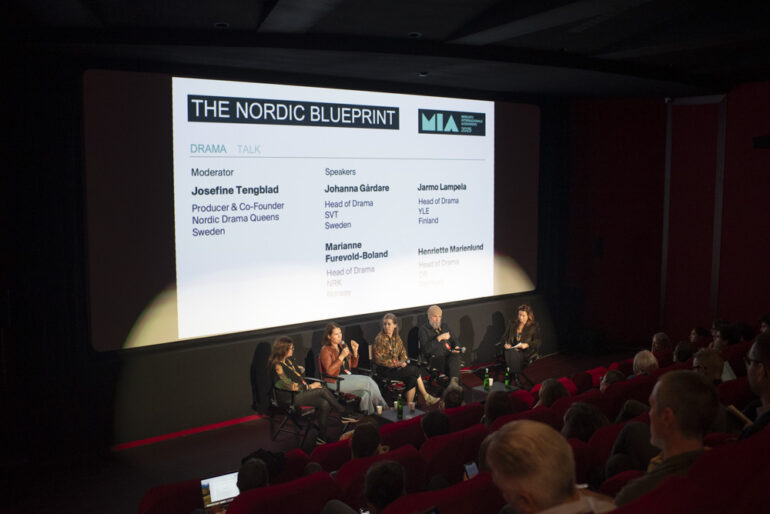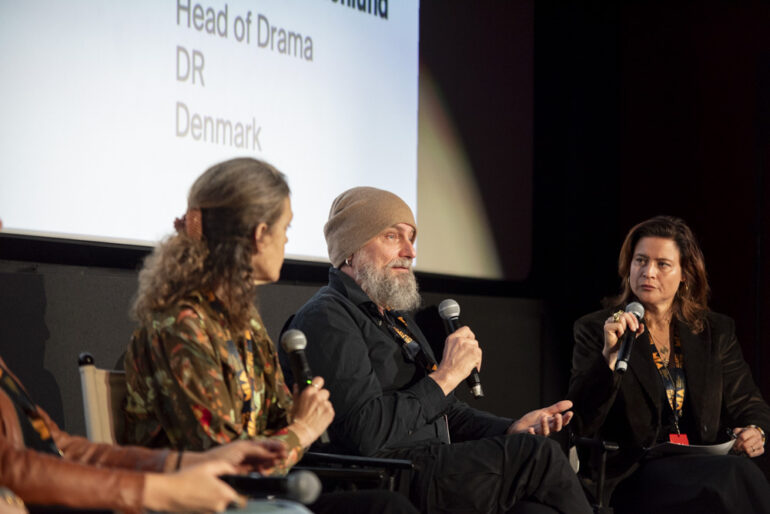WRITTEN BY: Davide Abbatescianni
The Italian industry event hosted a key talk about how Nordic pubcasters are reinventing collaboration, dealing with risks, and remaining relevant.
At this year’s MIA Market (6–10 October) in Rome, leading Nordic public broadcasters gathered to reflect on the future of drama production and the evolving role of public service media in a fragmented global landscape. Moderated by Josefine Tengblad, producer and co-founder of Nordic Drama Queens, the 7 October panel brought together heads of drama Henriette Marienlund (DR), Jarmo Lampela (Yle), Marianne Furevold-Boland (NRK), and Johanna Gårdare (SVT) to share insights on how the Nordic model is adapting to new creative and market realities.
Changing audiences and shrinking markets
The speakers agreed that audience behaviour has changed radically, especially among younger viewers. “They don’t come to our platforms anymore,” admitted Marienlund. “It’s not that they don’t care about quality — they just have so many choices.” Fiction is no longer the only driver, added Furevold-Boland, as non-fiction content increasingly attracts high viewership, forcing drama departments to look for distinctive, relevant stories that can stand out in a crowded field.
For Gårdare, the main concern is the contraction of the European market: “There are fewer commissioners ordering fewer series. How can we afford to take risks?” Lampela confirmed similar pressures in Finland, where several international players have withdrawn or reduced their investments. “After early 2023, HBO Nordic left, streamers cut commissioning, and commercial broadcasters froze theirs,” he recalled. Even though Yle remains a stable force, “government budget cuts have hit the cultural sector hard”. Still, there is optimism: Parliament has recently tasked Yle with increasing its commissioning by nearly €14 million over the next four years, a signal of continued faith in public broadcasting.
Balancing risk and relevance
At a time when public trust can no longer be taken for granted, Nordic broadcasters are working to balance creative risk and audience connection. “Ten years ago, people automatically trusted DR; now we must earn that attention again,” said Marienlund. Tengblad noted that viewers today “are loyal to titles, not broadcasters”, which demands a new mindset across all departments.
Gårdare emphasised SVT’s shift towards bolder choices, citing Blood Cruise (Färjan), a vampire horror co-produced with Imaginarium and CBS that tackles loneliness and belonging beneath its genre surface. “We aim for relevance and originality,” she said, “avoiding the glut of ‘cosy crime’ projects, and pushing creators to look beyond formula.” SVT even surveyed 100 scientists and experts on future societal challenges to inspire new stories — “a treasure trove of ideas”, she added.
Short formats and emerging talent
The Nordics are also redefining the relationship between format and innovation. Lampela explained that Yle treats long and short-form projects with equal seriousness, using micro-series as creative laboratories for new talent. The hit Rosita, about a young Roma woman dreaming of becoming a fashion designer, reached 1.6 million views and helped its creators transition to larger projects. “These formats allow experimentation at lower risk, while nurturing emerging voices,” he said.
Furevold-Boland reminded the audience that short-form storytelling is part of the Nordic DNA: “Skam is celebrating its tenth anniversary — short form has been ‘the future’ for over a decade.”
Marketing in a noisy world
Amid fierce competition for attention, marketing strategies have also evolved. Furevold-Boland pointed to NRK’s Requiem for Selina (Rekviem for Selina), which integrated audience engagement from the earliest development stages. “We worked with communities and influencers long before launch — no one was paid, it was about resonance and authenticity.”
Gårdare added that each title now requires a tailored approach. “We used to market the platform; now every project needs its own story.” Lampela described Yle’s resource constraints with humour: “We have ‘half a litre of marketing water’ for many projects,” he said, underlining the importance of organic and social-driven visibility to build phenomena from the ground up.
Looking outward while staying local
Despite a greater reliance on co-productions and international financing, the Nordic ethos remains deeply anchored in local storytelling. “We produce for Danes, in Danish, about Danish society,” said Marienlund. The others echoed the same principle, while acknowledging that global collaboration is essential for sustainability.
For NRK, public service remains a global value. “Our mandate is to strengthen democracy — and that resonates everywhere,” Furevold-Boland observed. Lampela added that Yle now evaluates international potential early in development: “We look for projects that feel universal yet remain true to their national voice.”
A blueprint for resilience
As Tengblad concluded, the Nordic model continues to evolve through courage, collaboration and adaptability. The region’s broadcasters are facing smaller markets, new audience habits, and tighter budgets, yet remain united by a clear mission: to deliver distinctive, socially engaged storytelling that connects local authenticity with global relevance.
The discussion in Rome reaffirmed why Nordic public service remains a reference point across Europe — not only as a creative engine, but as a strategic blueprint for resilience in a volatile media landscape.
Nordic projects on show
Nordic professionals were active throughout MIA, presenting projects across all sidebars. Key highlights included the animated feature Yap Yap (Denmark/France/Germany/Sweden), Peter Egeberg’s series Hidden Islands (Jagten på Nuna, Denmark), the Finnish doc Reflections of Gauguin, the Yle-backed drama series Hunting for Ghosts (Polku Pimeyteen), Dirty Play (co-produced with Norway), Seconds 2 (Sekunnit 2, co-produced with Estonia), and the Norwegian comedy Summer of Jesus. Together, they illustrated the creative diversity and cross-border collaboration of the region.
This year, MIA awarded projects from North Macedonia, Greece, Moldova, Ireland, Palestine, and Italy. The festival welcomed over 2,800 attendees from 64 countries, showcasing 62 projects across Animation, Documentary, Drama, and Film, plus 44 titles in five special showcases.

